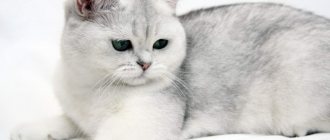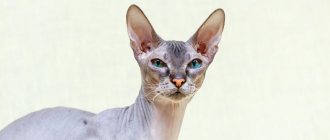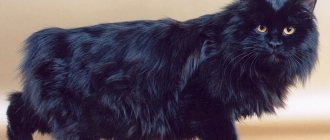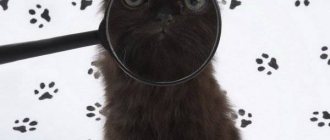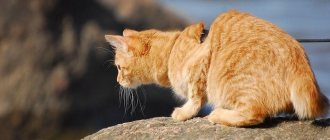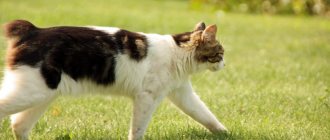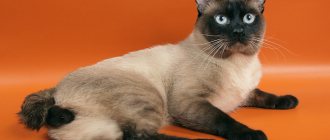/ Cats / Cat breeds / Bobtail cat breeds
0
5155
Article rating
Everyone knows the bobtail dog, or the Old English Sheepdog. But the British dog has nothing to do with our topic. It turns out that there are cat breeds with the same name. They come from different parts of the world, but share one characteristic - a short tail. The Bobtail is distinguished by a high level of intelligence, loyalty and devotion.
Bobtail
In some regions: the Kuril Islands, Karelia, the USA - these cats were originally wild, then they were domesticated. In Japan and Thailand they have been known for hundreds of years; many bobtails were considered sacred animals and lived at temples and in the houses of aristocrats.
Common signs of bobtail cats
There are several types of bobtail cats on earth today. They are all united according to several main characteristics:
- A short small tail measuring approximately 2 to 12 centimeters;
- Sufficiently long (longer than the front) and strong hind legs;
- Quite a low timbre of voice;
- No need to mark territory (unless two competing cats live in the same apartment);
- Muscular physique.
It is also worth noting the special character that distinguishes all cats of the breed: they are all fearless, well adapted to life in the wild, and able to stand up for themselves. But at the same time they have a devoted, almost dog-like heart. They become attached to the owner, and not to the place, they love him with all their cat soul. They lend themselves very well to classical training, the “fetch” command is easy to execute, and these amazing cats feel quite comfortable on walks, even if the owner walks his pet on a leash.
Kurilian Bobtail
Kurilian bobtails, true to their name, were found in the wild on the Kuril Islands. The place of residence influenced the appearance and physique of the smoker. The cat is distinguished by a rather severe-looking appearance: medium-length thick hair, a large head, wide cheekbones, a muscular, well-developed body, ears tilted forward, an arched back and a croup slightly raised due to the long hind limbs.
In the wild, a cat obtains food on its own, is an excellent rodent hunter, and an excellent fish catcher. Colors can be varied, with only a few species being exceptions to the standards. The tail of the Kurilian Bobtail cannot be straight. A straight tail is considered a breed defect, either very short or long (longer than 12 centimeters).
Despite its completely wild appearance, at home, a representative of this breed is an extremely friendly, affable, devoted animal. He loves affection, but not at the request of the owner, but only at his own request.
Does not tolerate coercion, violently protests against forced hugs or stroking.
But, having approached for a portion of the owner’s tenderness, he hopes to receive it in full, even with too much. He will never climb into his arms, but with pleasure he will lean back against his owner’s leg, he will purr in his gut, demonstrating in every possible way his complete pleasure. If a Kuril short-tailed cat lives in the house, there will never be mice or rats there; the Kuril will hunt until it has eliminated all the rodents in its possessions.
Features of care
Combing
The coat of the Kuril Bobtail is unique; it does not tangle or form tangles, and has no undercoat.
This type of wool does not require burdensome care.
It is enough to wash cats of this breed once every 1-2 months, although water procedures without cleansers can be used more often - Kuriles love to swim.
For more information on how to wash a cat, see this article.
to be combed with a furminator .
Bobtails do not need to trim their nails; it is worth monitoring the condition of their teeth and ears.
If there is discharge from the eyes, it is necessary to treat them with special medical solutions.
Kuriles are very sensitive; without attention and care, cats can become depressed.
Content and education
Both in an apartment and in a country house, Kurilian Bobtails feel equally comfortable.
Cats of this breed are playful and can be extremely restless - there must be space in the house for cat games and runs.
Kuriles are very sensitive; if they lack attention and care, cats can become depressed.
More about feline depression:
Raising islanders is not difficult; due to their natural intelligence, they will never harm their owner.
It is advisable to buy or make a scratching post for your pet , and also buy a flea and tick collar for walking.
Nutrition
The food of Kurilian bobtails should be balanced, regardless of whether it is dry food or natural.
Under no circumstances should these types of food be mixed. Bobtails are fed according to the following scheme:
- Kittens up to three months - 6 times a day
- Kittens up to six months - 4 times a day
- Cats after nine months - 2 times a day
When choosing natural food, you should give preference to those products that are more natural for bobtails - meat, sea fish, plant foods
Important! Since cats are nocturnal animals, they need to be given food at night. There must be clean food next to food.
When choosing natural food, you should give preference to those products that are more natural for bobtails - meat, sea fish, plant foods.
Karelian Bobtail
The Karelian bobtail is smaller in appearance and more graceful than the Kurilian. His head is more elongated, shaped like a triangle, his muzzle is quite narrow, there are no cheeks, there are only slightly convex whisker pads. The ears are large and vertical; the outer line of the ear seems to continue with the line of the head. Karelians come in short-haired and medium-haired varieties. The tail is from 4 to 13 centimeters. An individual distinctive feature of this type of bobtail: the hair on the tail is always longer than on the entire body, which is why the pom-pom effect occurs. Also, the Karelian tail can be straight, and not just broken. Unlike the Kurilian bobtail, the Karelian has a straight back without an arch. The types of colors are very numerous, the exceptions are exactly the same as for the Kurilian Bobtail.
The character of this short-tailed handsome man is very friendly and accommodating. In their natural environment, Karelian cats live in a pride, like lions, so they are simply forced to find a common language with all their neighbors.
The quality of the voice is amazing.
This cat sings as if a taiga bird is singing; experts from Germany even call Karelians “Tweeting cats.”
This cat will never yell at its owner if he needs something. But demonstrating your desire by gently touching it and then showing the direction of movement is very easy.
How to choose a kitten
Today, Kuril Bobtail nurseries are quite common, and you can choose a kitten to suit every taste.
It is recommended to adopt a small pet no earlier than three months of age; during this period you can already be sure that the baby will easily wean itself off mother’s milk and become independent.
Healthy Kurilian Bobtail kittens are active and playful, not aggressive. They have a wet nose, clean eyes and ears.
Purebred Kurils have recognized colors (most likely white, brown, tortoiseshell, black).
The tail is small in the form of a pompom, the head is trapezoidal.
Red kitten - Kurilian bobtail
Faults and defects are considered to be an overly arched back, lack of a tail, long tail, straight short tail, as well as unrecognized colors.
The Kurilian Bobtail, the price of which varies from 1,500 to 5,000 thousand, may be not purebred, defective, or without a pedigree.
The cost of purebred smokers can reach 15-30 thousand rubles.
In their natural habitat, Kurilian bobtails are excellent hunters. On the islands, these cats save houses from rodents, finding rat holes and destroying entire families. The Kuril Islands are not afraid of water at all, they catch fish very well and will always find food for themselves.
Japanese Bobtail
This cat is large (can weigh up to 14 kilograms), has an athletic build, a fluffy short tail and an appearance full of grace and elegance. According to ancient Japanese legend, a cat's tail is a repository of troubles, sorrows and vices. Accordingly, the absence of a tail in a cat entails all sorts of joy, happiness and prosperity. In Japan, Japanese bobtails, specifically cats, are called Maneki Neko (Hello Cat), in images the cat often has its front right paw raised up, as if in greeting, and also has a cute fluffy tail of a chrysanthemum-like appearance.
If this cat is frozen in some pose, then she clearly looks like a porcelain figurine, her coat is so neat, just hair to hair. The color, like many bobtails, can be any color (again, with the exception of just a few colors), but tortoiseshell colors with fiery red elements and white spots are traditional. Old descriptions of the breed give an idea of Japanese short-tailed cats as white cats with spots of red and black (mi-ke). It is believed that the white Japanese bobtail is a carrier of the gene for different eyes, the color of one is blue, the other is golden.
The Japanese have a distinctly triangular head, a long nose, and a clearly defined jawline. Well-drawn cheekbones protruding forward, high-set wide ears with small interesting tassels, large round eyes.
The Japanese Bobtail cat is curious, very active, tactful, and easy to communicate with. Energy simply pours out of all their limbs. This cat, if deprived of its movement, begins to show an explosive character, demonstrate dissatisfaction and misbehavior in every possible way.
Therefore, the cat is recommended to be kept with active families; she is simply prescribed long walks on a leash, active games with all sorts of moving and hanging toys.
It is advisable for owners to acquire scratching posts and special cat climbing frames. In gratitude for this, the owner will receive a cheerful, smart, active friend who can keep company on a walk, become a reliable playmate for children, a universal favorite and spoiled child. Japanese cats really do not like loneliness, do not tolerate it well, and yearn for human society.
Breed standard
The Old English Sheepdog is a fairly large, stocky dog with well-developed muscles. Power and strength are felt in all parts of the body. The height of adult individuals is 52-55 cm , weight is about 30-45 kg .
The scruff is well defined. A large head with a square-shaped skull rests on a high-set neck. The ears are hanging, not too large. The brow ridges stand out strongly. The eyes are oval-shaped, set wide apart, not large. The look is expressive and friendly. Dark eye color is preferable, it depends on the color. The muzzle is blunt, wide and long. The nose is black and large. The jaws are square and powerful. The canines are large, scissor bite.
The back is straight, there is a slight high back. The loin is wide, muscular, the ribs are convex. The chest is powerful. In most cases, Old English breeds are born with short tails. The tail is docked completely or below the level of the back without bending.
The legs are short compared to other herding breeds. With highly developed muscles, straight. The shoulders are slanted, the hocks are low and well developed. Profitable fingers must be removed. The paws are not too large, round in shape, and the paw pads are thick. When moving, it rearranges its hind legs like a bear.
The bobtail's coat is shaggy, harsh and long. Curls are not allowed. There is a waterproof undercoat that reliably protects the animal from wind, cold and natural precipitation. Such fur is found on the body, head and legs. It is customary to comb the hair on the head forward so that the eyes are covered with hair. The back of the body is noticeably more magnificent than the front. The tail is abundantly covered with hard, lush hair.
The coat color is quite varied. The following shades are allowed:
1. Gray-blue. 2. Bluish-marbled. 3. White. 4. Blue with black.
White or brown markings on the body and hind legs are not allowed.
American Bobtail
The American Bobtail cat breed (also called Yankeebob) is not related to other short-tailed breeds. They originated in America as a result of a gene mutation that turned into the highlight of the breed. The American Bobtail is a fairly large animal with a powerful body and a developed chest. The American has a flat back, with relief of the shoulder blades, which protrude slightly, and the paws are large, muscular, and round in shape. A square, wide head with prominent cheekbones, a clearly defined forehead, a strong chin, a medium nose, medium ears set wide with rounded tips. The coat can be either short or long, of any color.
The American cat has a very good-natured character, he is a wonderful companion, a loyal friend and a very smart pet with some dog-like habits. He will gladly bring his owner a toy or prey in the form of a caught mouse, but will never refuse to lie in the arms of any family member, while he will purr loudly and generally demonstrate in every way how happy he is, being in the company of a gentle, caring comrade .
Health
Characteristic diseases
Kurilian Bobtails are an unusually healthy breed of cat.
Centuries of natural selection have eliminated genetic and congenital diseases in these cats.
These are healthy and cheerful animals, but they can, however, contract diseases when kept at home.
The coat of the Kuril Bobtail is unique; it does not tangle or form tangles, and has no undercoat. This type of wool does not require burdensome care.
The main enemies of bobtails can be helminthiasis, in particular opisthorchiasis.
In order to avoid the development of parasitic diseases, it is recommended not only to regularly deworm the animal, but also to feed it with high-quality food and heat treat meat and fish.
This article will tell you more about how to treat cats for worms.
Vaccinations
The first vaccinations for Kuril Bobtail kittens are given at 8-12 weeks of life, vaccination is repeated after two to three months, then the procedure is carried out annually.
It is not recommended to vaccinate kittens at the age of 4-7 months (the period of teeth change). Before vaccination, a medical examination is carried out.
Kurilian Bobtails are an unusually healthy breed of cat. Centuries of natural selection have eliminated genetic and congenital diseases in these cats.
Mekong (Thai) Bobtail
The Mekong Bobtail (the old name of the Thai Bobtail breed) is a cat whose origin is covered in the legend of the sacred Thai animal. These cats existed back in the days when countless and innumerable treasures were kept in the Buddhist temples of Ancient Siam. These cats guarded the Siamese princesses, accompanying the beauties everywhere. While bathing, Thai high-ranking girls took off their jewelry and hung their guard cats on the broken and twisted short tails, from which they could not fall and get lost.
Mekong Bobtail cats resemble their Siamese friends: the same wedge-shaped head, only with rounded shapes, the same slanting large almond-shaped eyes of a piercing blue color. And, most importantly, it is a unique color-point color of various species.
The hind legs of this type of bobtail have a distinctive feature - the claws on them do not retract inside the pads, so a light tapping sound is heard when walking.
A characteristic behavioral feature of the Mekong Bobtail is a clear imitation of dog manners. This doesn't just show up in games. During a walk, the cat will behave completely like a dog: walk next to the owner, demonstrating complete obedience, and in case of danger, he will certainly rush at the offender.
But during the breeding and raising of offspring, an amazing distribution of responsibilities will be observed, not typical of other breeds. After giving birth to kittens, a bobtail cat feeds the babies and minimally cares for them. But the cat takes on the main functions of raising the heirs: he licks them, teaches them all sorts of wisdom and behaves like a real father of the family. In addition, the Mekong Bobtail cat, having created a family with a cat, behaves completely atypically for cats; he remains faithful to his cat, unless a person forces him to mate with another partner.
Historical reference
Kuril short-tailed cats are a relatively new indigenous breed. Hundreds of years ago it was known that funny cats with stubby tails lived on the islands of the Kuril ridge. In the 20th century, archaeologists and the military often brought them to the mainland. But they became interested in them only in the 80s of the last century. There were felinology enthusiasts who showed the cats to foreign experts and began breeding them themselves.
In October 1991, the Soviet Feline Federation (SFF) introduced the first breed standard. In 1995, the standard was adopted by WCF. In 2001, the modern standard was clarified and approved. WCF and FIFe recognize two breeds: semi-longhaired and shorthaired Kurilian Bobtail.
Other types of bobtails
Oriental Bobtail - bred in Great Britain, is experimental, named after the oriental color.
Snow Bob - also got its name because of its color, reminiscent of the Alaskan lynx.
Oohee-bob - obtained as a result of mating a Siamese cat and a Manx (tailless cat), has a bi-color or color-point color.
The toy bobtail has a toy size, like a kitten, and absolutely childlike mischievous behavior.
Character
It is impossible to identify any common character traits of Old English Sheepdogs. They are like people, each with their own characteristics, habits, preferences. Some are serious and unsociable, others are cheerful and sociable, others always try to be the center of attention and do not like competition.
If we try to highlight the commonality in the character of bobtails, it will be their devotion to the owner and all household members. These dogs also love children, are always ready to play with them and will defend the child in any situation.
The Old English Sheepdog has the blood of a shepherd dog in its veins. That is why she is an excellent watchman, quickly reacting to the invasion of strangers into her territory, promptly warning the owners about guests, invited or uninvited. The bobtail treats other pets well, but always tries to bring everyone together. This is a habit due to the shepherd's instinct, the Old English strives to gather even members of the household in one place so that everyone is in his field of vision.

